The Volume Stability of Alkali-Activated Electric Arc Furnace Ladle Slag Mortar and Its Performance at High Temperatures
Abstract
:1. Introduction
2. Materials and Methods
2.1. Materials
2.2. Material Testing and Analysis Methods
3. Results and Discussion
3.1. The Volume Stability of Alkali-Activated Electric Arc Furnace Ladle Slag Paste
3.2. Properties of Alkali-Activated Electric Arc Furnace Ladle Slag Mortar at High Temperatures
4. Conclusions
- Using EAFLS in OPC mortar would cause volume instability due to the presence of free-CaO and free-MgO in the EAFLS slag. On the other hand, alkali-activated technology can accelerate the hydration process and resolve the delayed hydration problem. The length change of alkali-activated slag-control (AAS) and AAS with 20% EAFLS (AASLS) were only 0.081% and 0.149%, respectively. Therefore, EAFLS can become stable when used in an AAS mortar;
- Adding EAFLS in the specific OPC mortar would decrease the compressive strength, resulting in failure to meet the criteria (ASTM C1157/C1157M). Alkali-activated technology could increase EAFLS cementitious properties for satisfying the criteria. For example, a 20% EAFLS replacement decreased the compressive strength by 27% in OPC in 28 days. On the other hand, AASLS exhibited increasing compressive strength by up to 105% since AAS technology can accelerate the hydration process and in turn enhance the cementitious properties of EAFLS.
- Furthermore, alkali-activated technology also leads to good high-temperature resistance in cementitious materials. The compressive strength (MPa) of AAS and AASLS were 3.2 MPa and 4.9 MPa at 800 °C, respectively. It makes it possible to increase compressive strength by more than 5%, even at temperatures as high as 800 °C.
Author Contributions
Funding
Acknowledgments
Conflicts of Interest
References
- Nguyen, T.T.H.; Mai, H.H.; Phan, D.H.; Nguyen, D.L. Responses of concrete using steel slag as coarse aggregate replacement under splitting and flexure. Sustainability 2020, 12, 4913. [Google Scholar] [CrossRef]
- Andrés-Vizán, S.M.; Villanueva-Balsera, J.M.; Álvarez-Cabal, J.V.; Martínez-Huerta, G.M. Classification of BOF slag by data mining techniques according to chemical composition. Sustainability 2020, 12, 3301. [Google Scholar] [CrossRef] [Green Version]
- Du, C.; Gao, X.; Kitamura, S.Y. Measures to Decrease and Utilize Steelmaking Slag. J. Sustain. Metall. 2019, 5, 141–153. [Google Scholar] [CrossRef]
- Brand, A.S.; Roesler, J.R. Steel furnace slag aggregate expansion and hardened concrete properties. Cem. Concr. Compos. 2015, 60, 1–9. [Google Scholar] [CrossRef]
- González-Ortega, M.A.; Cavalaro, S.H.P.; Rodríguez de Sensale, G.; Aguado, A. Durability of concrete with electric arc furnace slag aggregate. Constr. Build. Mater. 2019, 217, 543–556. [Google Scholar] [CrossRef]
- Shi, C.; Hu, S. Cementitious properties of ladle slag fines under autoclave curing conditions. Cem. Concr. Res. 2003, 33, 1851–1856. [Google Scholar] [CrossRef]
- Lu, T.H.; Chen, Y.L.; Shih, P.H.; Chang, J.E. Use of basic oxygen furnace slag fines in the production of cementitious mortars and the effects on mortar expansion. Constr. Build. Mater. 2018, 167, 768–774. [Google Scholar] [CrossRef]
- Emery, J.J. Slag utilization in pavement construction. In Extending Aggregate Resources; ASTM International: West Conshohocken, PA, USA, 1982. [Google Scholar]
- Yildirim, I.Z.; Prezzi, M. Chemical, mineralogical, and morphological properties of steel slag. Adv. Civ. Eng. 2011, 2011, 463638. [Google Scholar] [CrossRef] [Green Version]
- Das, B.; Prakash, S.; Reddy, P.S.R.; Misra, V.N. An overview of utilization of slag and sludge from steel industries. Resour. Conserv. Recycl. 2007, 50, 40–57. [Google Scholar] [CrossRef]
- Shi, C. Characteristics and cementitious properties of ladle slag fines from steel production. Cem. Concr. Res. 2002, 32, 459–462. [Google Scholar] [CrossRef]
- Tossavainen, M.; Engstrom, F.; Yang, Q.; Menad, N.; Larsson, M.L.; Bjorkman, B. Characteristics of steel slag under different cooling conditions. Waste Manag. 2007, 27, 1335–1344. [Google Scholar] [CrossRef] [PubMed]
- Motz, H.; Geiseler, J. Products of steel slags an opportunity to save natural resources. Waste Manag. 2001, 21, 285–293. [Google Scholar] [CrossRef]
- Geiseler, J. Use of steelworks slag in Europe. Waste Manag. 1996, 16, 59–63. [Google Scholar] [CrossRef]
- Wu, S.; Xue, Y.; Ye, Q.; Chen, Y. Utilization of steel slag as aggregates for stone mastic asphalt (SMA) mixtures. Build. Environ. 2007, 42, 2580–2585. [Google Scholar] [CrossRef]
- Santamaria, A.; Faleschini, F.; Giacomello, G.; Brunelli, K.; San José, J.-T.; Pellegrino, C.; Pasetto, M. Dimensional stability of electric arc furnace slag in civil engineering applications. J. Clean. Prod. 2018, 205, 599–609. [Google Scholar] [CrossRef]
- Pellegrino, C.; Gaddo, V. Mechanical and durability characteristics of concrete containing EAF slag as aggregate. Cem. Concr. Compos. 2009, 31, 663–671. [Google Scholar] [CrossRef]
- Wang, W.C. Feasibility of stabilizing expanding property of furnace slag by autoclave method. Constr. Build. Mater. 2014, 68, 552–557. [Google Scholar] [CrossRef]
- Lee, W.H.; Cheng, T.W.; Lin, K.Y.; Lin, K.L.; Wu, C.C.; Tsai, C.T. Geopolymer technologies for stabilization of basic oxygen furnace slags and sustainable application as construction materials. Sustainability 2020, 12, 5002. [Google Scholar] [CrossRef]
- Puertas, F.; Martínez-Ramírez, S.; Alonso, S.; Vázquez, T. Alkali-activated fly ash/slag cements. Strength behaviour and hydration products. Cem. Concr. Res. 2000, 30, 1625–1632. [Google Scholar] [CrossRef]
- Guerrieri, M.; Sanjayan, J.G. Behavior of combined fly ash/slag-based geopolymers when exposed to high temperatures. Fire Mater. Int. J. 2010, 34, 163–175. [Google Scholar] [CrossRef]
- Zuda, L.; Rovnaník, P.; Bayer, P.; Černý, R. Thermal properties of alkali-activated slag subjected to high temperatures. J. Build. Phys. 2007, 30, 337–350. [Google Scholar] [CrossRef]
- Buchwald, A.; Hilbig, H.; Kaps, C. Alkali-activated metakaolin-slag blends—Performance and structure in dependence of their composition. J. Mater. Sci. 2007, 42, 3024–3032. [Google Scholar] [CrossRef]
- Guerrieri, M.; Sanjayan, J.; Collins, F. Residual strength properties of sodium silicate alkali activated slag paste exposed to elevated temperatures. Mater. Struct. Constr. 2010, 43, 765–773. [Google Scholar] [CrossRef]
- Mendes, A.; Sanjayan, J.; Collins, F. Phase transformations and mechanical strength of OPC/Slag pastes submitted to high temperatures. Mater. Struct. Constr. 2008, 41, 345–350. [Google Scholar] [CrossRef]
- Natali Murri, A.; Rickard, W.D.A.; Bignozzi, M.C.; VanRiessen, A. High temperature behaviour of ambient cured alkali-activated materials based on ladle slag. Cem. Concr. Res. 2013, 43, 51–61. [Google Scholar] [CrossRef]
- Juenger, M.C.G.; Winnefeld, F.; Provis, J.L.; Ideker, J.H. Advances in alternative cementitious binders. Cem. Concr. Res. 2011, 41, 1232–1243. [Google Scholar] [CrossRef]
- Duxson, P.; Fernández-Jiménez, A.; Provis, J.L.; Lukey, G.C.; Palomo, A.; van Deventer, J.S.J. Geopolymer technology: The current state of the art. J. Mater. Sci. 2007, 42, 2917–2933. [Google Scholar] [CrossRef]
- Davidovits, J.; Comrie, D.C.; Paterson, J.H.; Ritcey, D.J. Geopolymeric concretes for environmental protection. Concr. Int. 1990, 12, 30–40. [Google Scholar]
- Pacheco-Torgal, F.; Abdollahnejad, Z.; Camões, A.F.; Jamshidi, M.; Ding, Y. Durability of alkali-activated binders: A clear advantage over Portland cement or an unproven issue? Constr. Build. Mater. 2012, 30, 400–405. [Google Scholar] [CrossRef] [Green Version]
- Fernandez-Jimenez, A.; García-Lodeiro, I.; Palomo, A. Durability of alkali-activated fly ash cementitious materials. J. Mater. Sci. 2007, 42, 3055–3065. [Google Scholar] [CrossRef]
- Bakharev, T.; Sanjayan, J.G.; Cheng, Y.B. Resistance of alkali-activated slag concrete to acid attack. Cem. Concr. Res. 2003, 33, 1607–1611. [Google Scholar] [CrossRef]
- Faleschini, F.; Brunelli, K.; Zanini, M.A.; Dabalà, M.; Pellegrino, C. Electric Arc Furnace Slag as Coarse Recycled Aggregate for Concrete Production. J. Sustain. Metall. 2016, 2, 44–50. [Google Scholar] [CrossRef]
- Almulhim, M.S.M.; Hunt, D.V.L.; Rogers, C.D.F. A resilience and environmentally sustainable assessment framework (RESAF) for domestic building materials in Saudi Arabia. Sustainability 2020, 12, 3092. [Google Scholar] [CrossRef] [Green Version]
- Wang, W.; Noguchi, T. Alkali-silica reaction (ASR) in the alkali-activated cement (AAC) system: A state-of-the-art review. Constr. Build. Mater. 2020, 252, 119105. [Google Scholar] [CrossRef]
- ASTM.C33/C33M-18; Standard Specification for Concrete Aggregates. ASTM International: West Conshohocken, PA, USA, 2018.
- ASTM.C305-20; Standard Practice for Mechanical Mixing of Hydraulic Cement Pastes and Mortars of Plastic Consistency. ASTM International: West Conshohocken, PA, USA, 2020.
- ASTM.C151/C151M-18; Standard Test Method for Autoclave Expansion of Hydraulic Cement. ASTM International: West Conshohocken, PA, USA, 2018.
- ASTM.C109/C109M-16a; Standard Test Method for Compressive Strength of Hydraulic Cement Mortars (Using 2-in. or [50-mm] Cube Specimens). ASTM International: West Conshohocken, PA, USA, 2016.
- Kneller, W.A.; Gupta, J.; Borkowski, M.L.; Dollimore, D. Determination of original free lime content of weathered iron and steel slags by thermogravimetric analysis. Transp. Res. Rec. 1994, 1434, 17–22. [Google Scholar]
- ASTM.C114-18; Standard Test Methods for Chemical Analysis of Hydraulic Cement. ASTM International: West Conshohocken, PA, USA, 2018.
- Chatterji, S. Mechanism of expansion of concrete due to the presence of dead-burnt CaO and MgO. Cem. Concr. Res. 1995, 25, 51–56. [Google Scholar] [CrossRef]
- Min, D.; Dongwen, H.; Xianghui, L.; Mingshu, T. Mechanism of expansion in hardened cement pastes with hard-burnt lime. Cem. Concr. Res. 1996, 26, 647–648. [Google Scholar] [CrossRef]
- Ali, M.M.; Mullick, A.K. Volume stabilisation of high MgO cement: Effect of curing conditions and fly ash addition. Cem. Concr. Res. 1998, 28, 1585–1594. [Google Scholar] [CrossRef]
- Chatterji, S.; Jeffery, J.W. The volume expansion of hardened cement paste due to the presence of “dead-burnt” CaO. Mag. Concr. Res. 1966, 18, 65–68. [Google Scholar] [CrossRef]
- Montenegro, J.M.; Celemín-Matachana, M.; Cañizal, J.; Setién, J. Ladle furnace slag in the construction of embankments: Expansive behavior. J. Mater. Civ. Eng. 2013, 25, 972–979. [Google Scholar] [CrossRef]
- Suito, H.; Yokomaku, T.; Hayashida, Y.; Takahashi, Y. Effect of free lime on disintegration of LD slags. Tetsu-To-Hagané 1977, 63, 2316–2325. [Google Scholar] [CrossRef] [Green Version]
- Mo, L.; Deng, M.; Tang, M. Effects of calcination condition on expansion property of MgO-type expansive agent used in cement-based materials. Cem. Concr. Res. 2010, 40, 437–446. [Google Scholar] [CrossRef]
- Wang, S.-D.; Pu, X.-C.; Scrivener, K.L.; Pratt, P.L. Alkali-activated slag cement and concrete: A review of properties and problems. Adv. Cem. Res. 1995, 7, 93–102. [Google Scholar] [CrossRef]
- ASTM.C1157/C1157M-17; Standard Performance Specification for Hydraulic Cement. ASTM International: West Conshohocken, PA, USA, 2017.
- ASTM.C618-19; Standard Specification for Coal Fly Ash and Raw or Calcined Natural Pozzolan for Use in Concrete. ASTM International: West Conshohocken, PA, USA, 2019.
- Kourounis, S.; Tsivilis, S.; Tsakiridis, P.E.; Papadimitriou, G.D.; Tsibouki, Z. Properties and hydration of blended cements with steelmaking slag. Cem. Concr. Res. 2007, 37, 815–822. [Google Scholar] [CrossRef]
- Yip, C.K.; Lukey, G.C.; van Deventer, J.S.J. The coexistence of geopolymeric gel and calcium silicate hydrate at the early stage of alkaline activation. Cem. Concr. Res. 2005, 35, 1688–1697. [Google Scholar] [CrossRef]
- Bignozzi, M.C.; Manzi, S.; Lancellotti, I.; Kamseu, E.; Barbieri, L.; Leonelli, C. Mix-design and characterization of alkali activated materials based on metakaolin and ladle slag. Appl. Clay Sci. 2013, 73, 78–85. [Google Scholar] [CrossRef]
- Puertas, F.; Palacios, M.; Manzano, H.; Dolado, J.S.; Rico, A.; Rodríguez, J. A model for the C-A-S-H gel formed in alkali-activated slag cements. J. Eur. Ceram. Soc. 2011, 31, 2043–2056. [Google Scholar] [CrossRef]
- Khoury, G.A. Compressive strength of concrete at high temperatures: A reassessment. Mag. Concr. Res. 1992, 44, 291–309. [Google Scholar] [CrossRef]
- Georgali, B.; Tsakiridis, P.E. Microstructure of fire-damaged concrete. A case study. Cem. Concr. Compos. 2005, 27, 255–259. [Google Scholar] [CrossRef]
- Handoo, S.K.; Agarwal, S.; Agarwal, S.K. Physicochemical, mineralogical, and morphological characteristics of concrete exposed to elevated temperatures. Cem. Concr. Res. 2002, 32, 1009–1018. [Google Scholar] [CrossRef]
- Aydın, S.; Baradan, B. High Temperature Resistance of Alkali-Activated Slag-and Portland Cement-Based Reactive Powder Concrete. ACI Mater. J. 2012, 109, 463–470. [Google Scholar]
- Saavedra, W.G.V.; de Gutiérrez, R.M. Performance of geopolymer concrete composed of fly ash after exposure to elevated temperatures. Constr. Build. Mater. 2017, 154, 229–235. [Google Scholar] [CrossRef]
- Pan, Z.; Tao, Z.; Cao, Y.F.; Wuhrer, R.; Murphy, T. Compressive strength and microstructure of alkali-activated fly ash/slag binders at high temperature. Cem. Concr. Compos. 2018, 86, 9–18. [Google Scholar] [CrossRef]
- Rovnaník, P.; Bayer, P.; Rovnaníková, P. Characterization of alkali activated slag paste after exposure to high temperatures. Constr. Build. Mater. 2013, 47, 1479–1487. [Google Scholar] [CrossRef]
- Rashad, A.M.; Sadek, D.M.; Hassan, H.A. An investigation on blast-furnace stag as fine aggregate in alkali-activated slag mortars subjected to elevated temperatures. J. Clean. Prod. 2016, 112, 1086–1096. [Google Scholar] [CrossRef]
- Zuda, L.; Rovnaník, P.; Bayer, P.; Černý, R. Effect of high temperatures on the properties of alkali activated aluminosilicate with electrical porcelain filler. Int. J. Thermophys. 2008, 29, 693–705. [Google Scholar] [CrossRef]
- Zuda, L.; Pavlík, Z.; Rovnaníková, P.; Bayer, P.; Černý, R. Properties of Alkali Activated Aluminosilicate Material after Thermal Load. Int. J. Thermophys. 2006, 27, 1250–1263. [Google Scholar] [CrossRef]
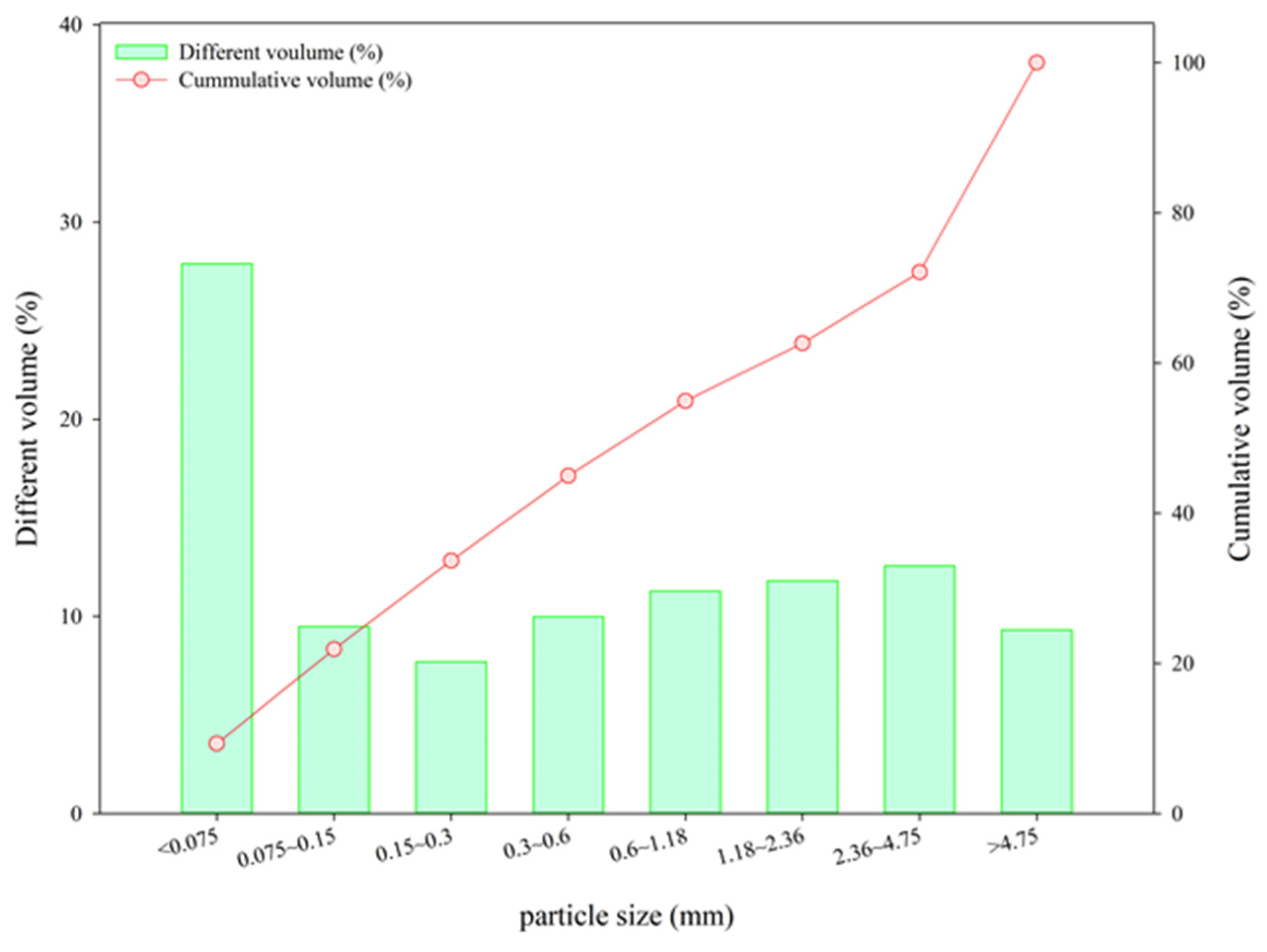
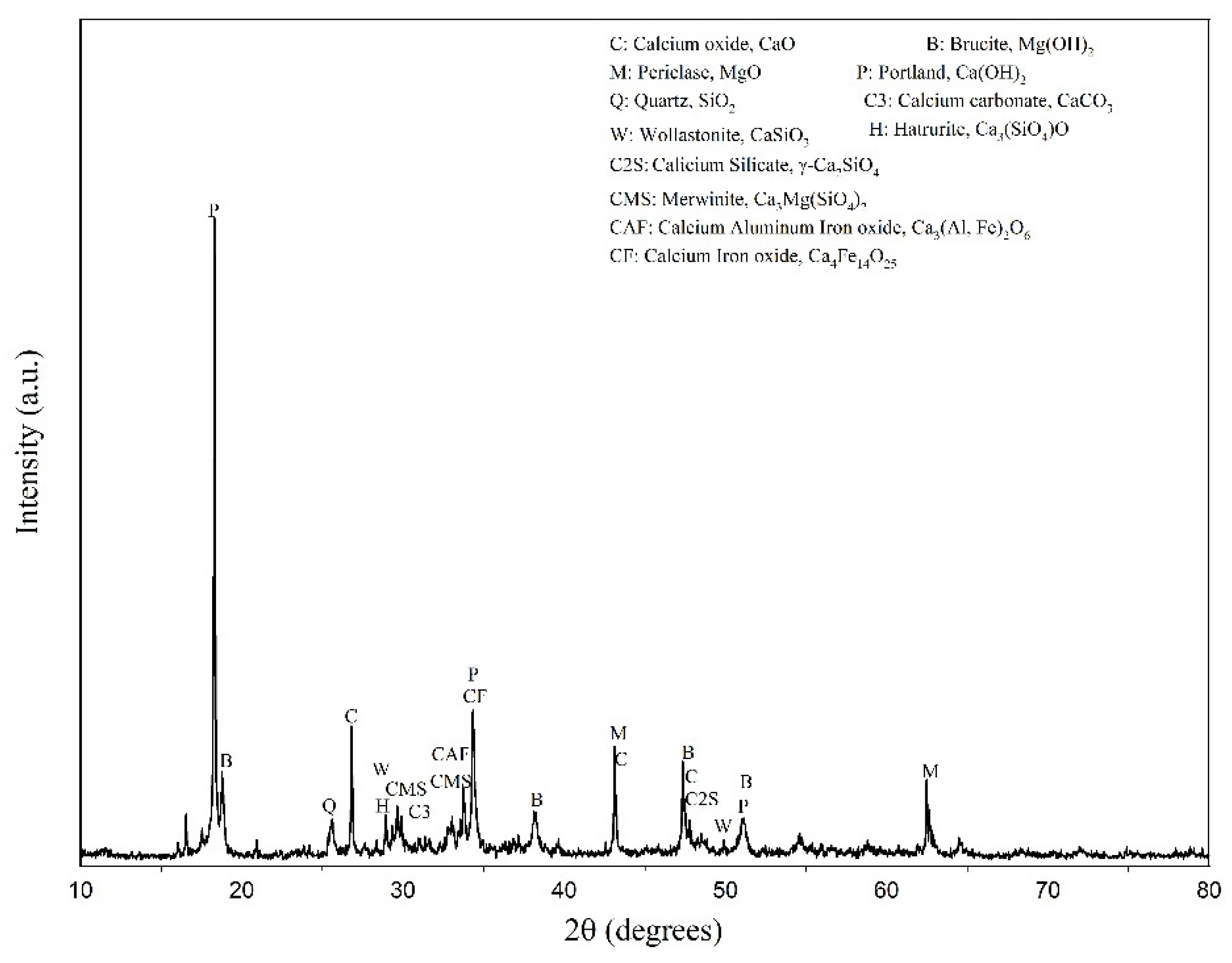
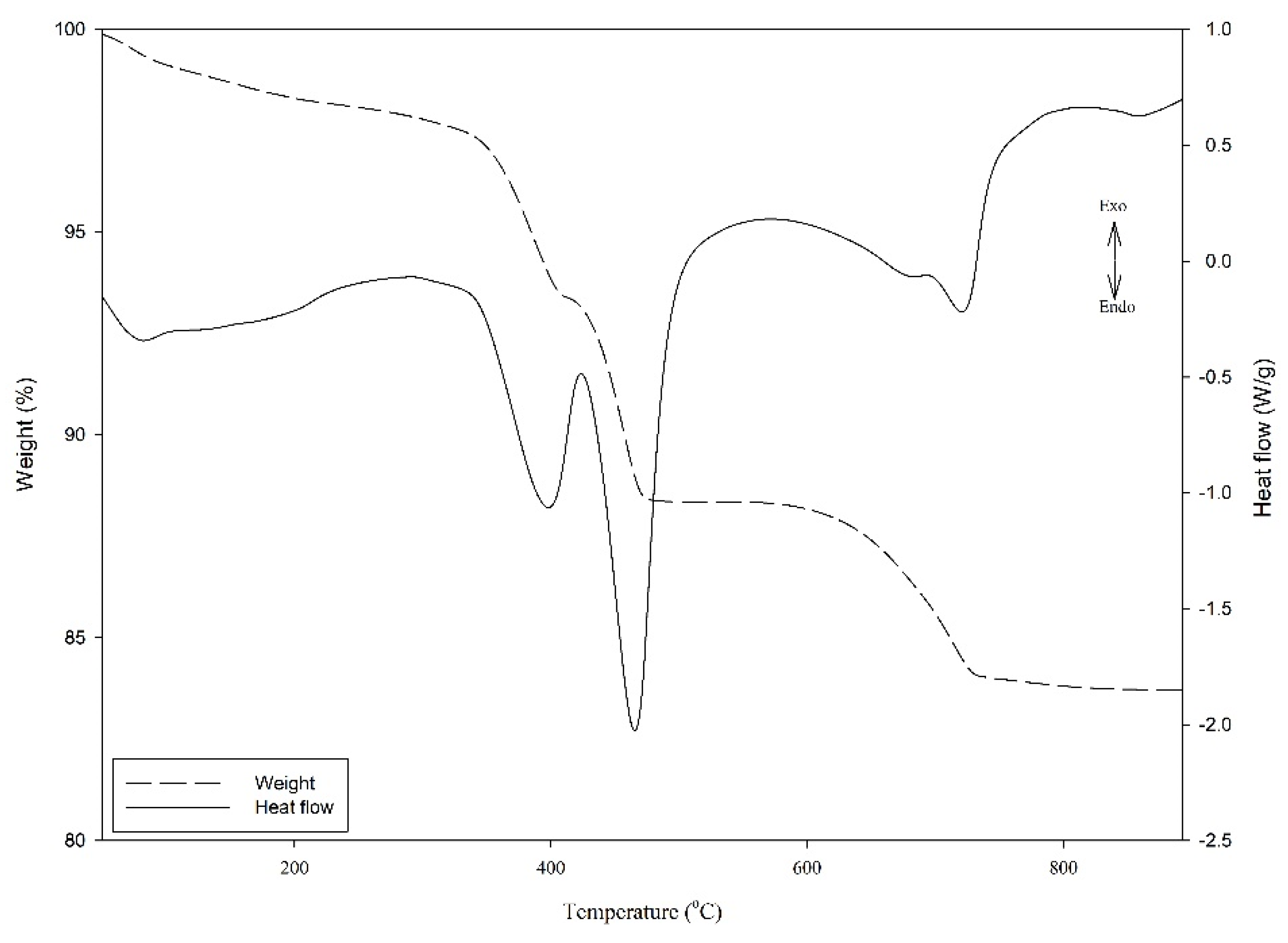
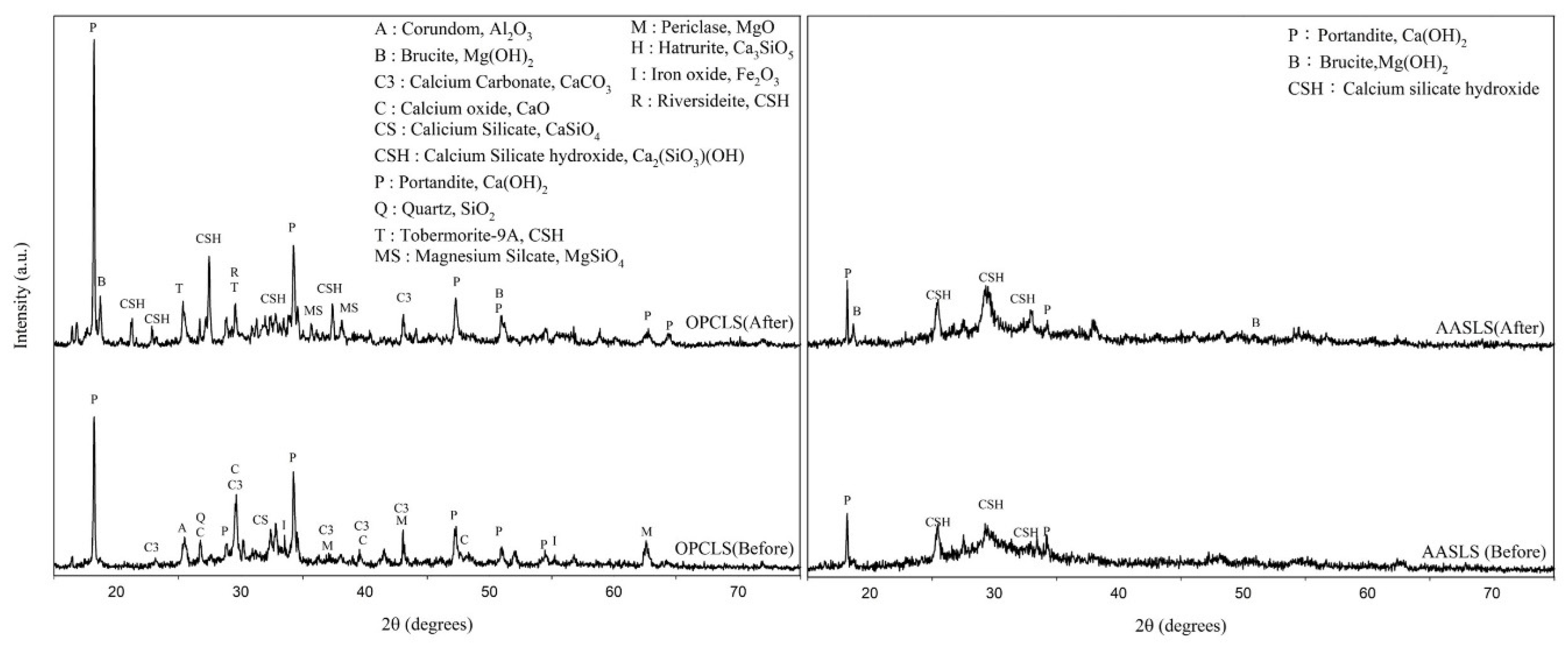

| Chemical Composition | Electric Arc Furnace Ladle Slag | |
|---|---|---|
| Element (wt%) | Ca | 29.25 |
| Si | 4.77 | |
| Al | 2.24 | |
| Fe | 2.83 | |
| Mg | 6.75 | |
| Specimen | W/B | OPC | Sand | GGBFS | EAFLS | Water | NaOH | Na2SiO3 |
|---|---|---|---|---|---|---|---|---|
| OPC-paste | 0.28 | 1000.0 | - | - | - | 280.0 | - | - |
| OPCLS-paste | 0.28 | 800.0 | - | - | 200.0 | 280.0 | - | - |
| AAS-paste | 0.28 | - | - | 1000.0 | - | 116.0 | 70.1 | 191.0 |
| AASLS-paste | 0.28 | - | - | 800.0 | 200.0 | 116.0 | 70.1 | 191.0 |
| OPC-mortar | 0.5 | 1000.0 | 2750.0 | - | - | 500.0 | - | - |
| OPCLS-mortar | 0.5 | 800.0 | 2750.0 | - | 200.0 | 500.0 | - | - |
| AAS-mortar | 0.5 | - | 2750.0 | 1000.0 | - | 336.0 | 70.1 | 191.0 |
| AASLS-mortar | 0.5 | - | 2750.0 | 800.0 | 200.0 | 336.0 | 70.1 | 191.0 |
| Specimen | Length Change (%) | Soundness Expansion * | After the Autoclave Expansion Test |
|---|---|---|---|
| OPC | 0.111 | Stable | 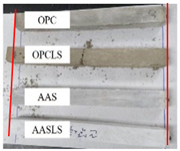 |
| OPC with 20% EAFLS (OPCLS) | Crack | Unstable | |
| Alkali-activated slag—control (AAS) | 0.081 | Stable | |
| AAS with 20% EAFLS (AASLS) | 0.149 | Stable |
| Specimen | Ca(OH)2 (%) | Mg(OH)2 (%) | Free-CaO (%) | ||
|---|---|---|---|---|---|
| Before | After | Before | After | Before | |
| OPCLS | 12.58 | 23.05 | 3.44 | 11.03 | 11.84 |
| AASLS | 4.22 | 4.29 | 2.67 | 4.67 | 0.84 |
| Curing Time (Days) | Compressive Strength (MPa) | Relative Compressive Strength (%) | |||||
|---|---|---|---|---|---|---|---|
| OPC | OPCLS | AAS | AASLS | OPCLS | AAS | AASLS | |
| 3 | 22.3 | 16.3 | 28.5 | 25.9 | 73.1 | 127.8 | 116.1 |
| 7 | 28.9 | 20.2 | 32.7 | 29.3 | 69.9 | 113.1 | 101.4 |
| 28 | 32.1 | 23.5 | 40.9 | 33.8 | 73.2 | 127.4 | 105.3 |
| Specimen | Compressive Strength (MPa) | |||
|---|---|---|---|---|
| Normal | 200 °C | 550 °C | 800 °C | |
| OPC | 32.1 | 35.6 | Crack | Crack |
| OPCLS | 21.8 | 23.1 | Crack | Crack |
| AAS | 40.9 | 46.5 | 40.4 | 3.2 |
| AASLS | 34.2 | 36.3 | 31.6 | 4.9 |
Publisher’s Note: MDPI stays neutral with regard to jurisdictional claims in published maps and institutional affiliations. |
© 2022 by the authors. Licensee MDPI, Basel, Switzerland. This article is an open access article distributed under the terms and conditions of the Creative Commons Attribution (CC BY) license (https://creativecommons.org/licenses/by/4.0/).
Share and Cite
Lu, T.-H.; Chen, Y.-L.; Wang, H.-P.; Chang, J.-E. The Volume Stability of Alkali-Activated Electric Arc Furnace Ladle Slag Mortar and Its Performance at High Temperatures. Processes 2022, 10, 700. https://doi.org/10.3390/pr10040700
Lu T-H, Chen Y-L, Wang H-P, Chang J-E. The Volume Stability of Alkali-Activated Electric Arc Furnace Ladle Slag Mortar and Its Performance at High Temperatures. Processes. 2022; 10(4):700. https://doi.org/10.3390/pr10040700
Chicago/Turabian StyleLu, Tung-Hsuan, Ying-Liang Chen, Hong-Paul Wang, and Juu-En Chang. 2022. "The Volume Stability of Alkali-Activated Electric Arc Furnace Ladle Slag Mortar and Its Performance at High Temperatures" Processes 10, no. 4: 700. https://doi.org/10.3390/pr10040700
APA StyleLu, T.-H., Chen, Y.-L., Wang, H.-P., & Chang, J.-E. (2022). The Volume Stability of Alkali-Activated Electric Arc Furnace Ladle Slag Mortar and Its Performance at High Temperatures. Processes, 10(4), 700. https://doi.org/10.3390/pr10040700








